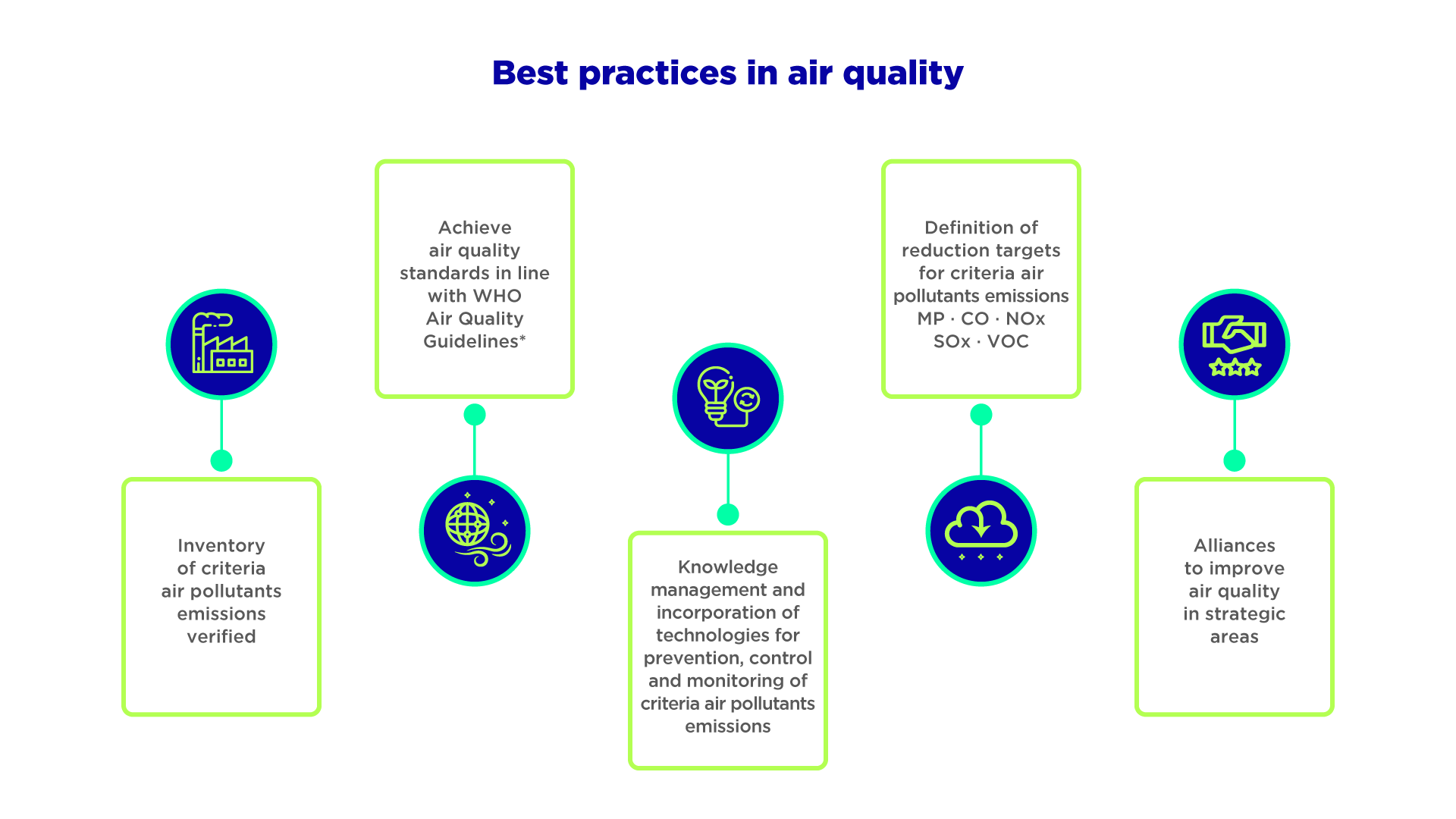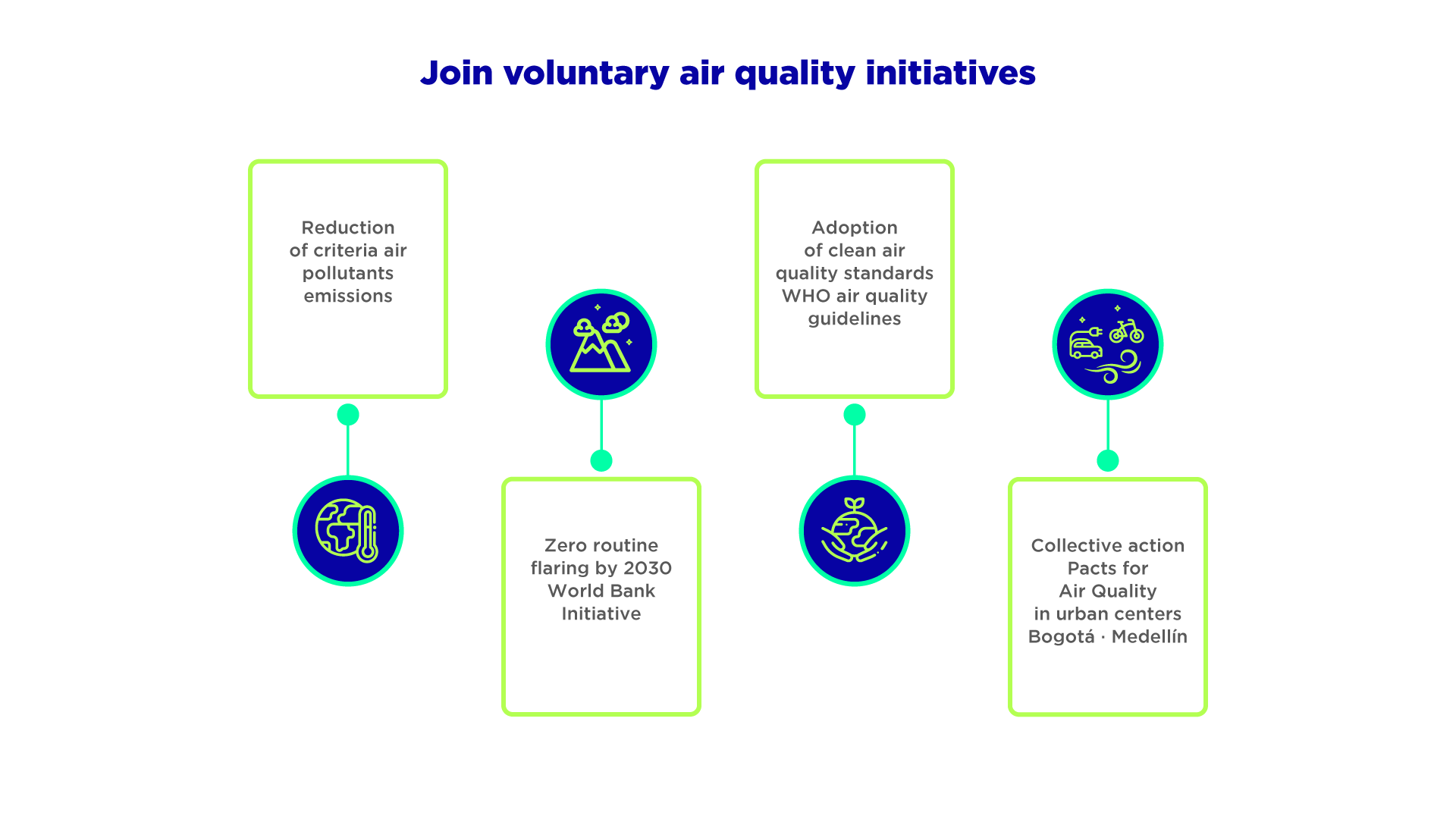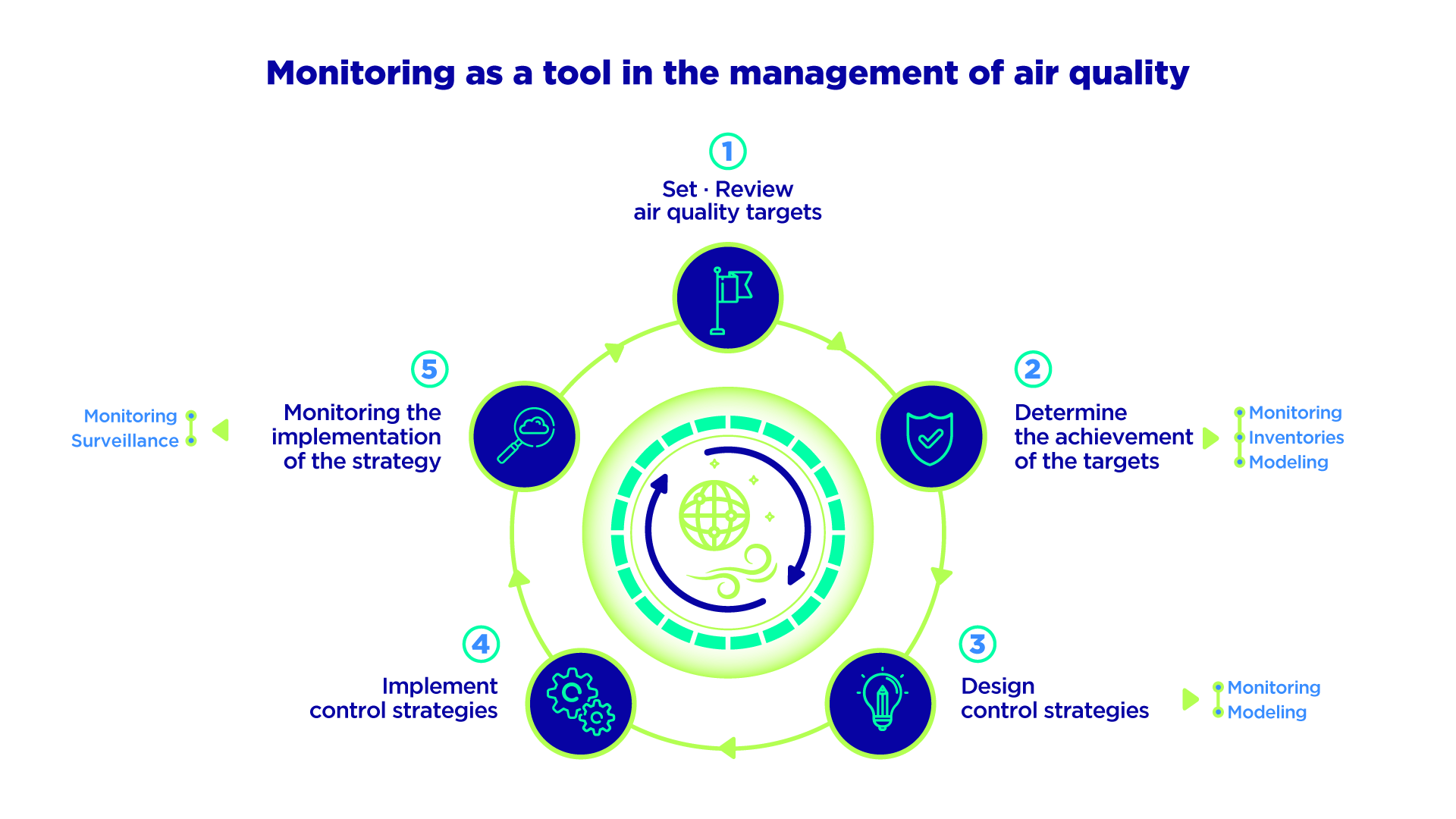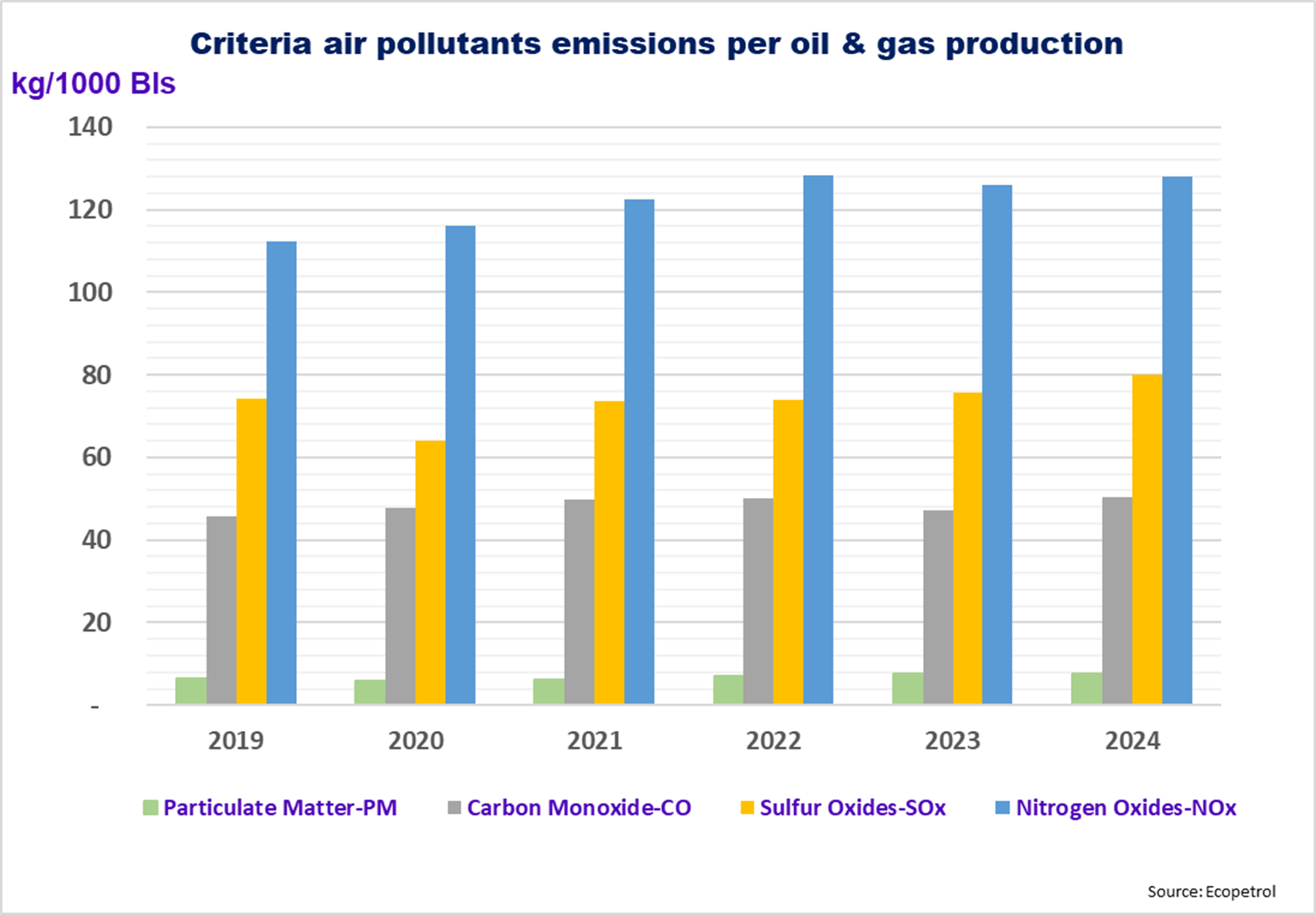 PautaInternas
PautaInternas
 Air quality in the environment
Air quality in the environment
Air quality in the environment
Apr 8, 2025
Commitment to air quality

Ecopetrol, as a relevant player in the energy industry in Colombia, has a commitment to air quality for the well-being of Colombians, both from the point of view of health care and from the care of the environment.
An air quality roadmap was established in 2021, whose objectives are aligned with Ecopetrol's efforts in terms of fuels quality, to contribute to the great aspiration of having clean air, aligned with the objectives of the World Organization for Health established in their Air Quality Guidelines.
|
The air quality roadmap establishes the implementation of best practices in terms of emissions management that includes: |
|||
|---|---|---|---|
|
|||
|
|||
|
|||
|
|||
¹ Criteria Air pollutants: Particulate Matter (PM), Nitrogen Oxides (NOx), Sulfur Oxides (SOx), Carbon Monoxide (CO) |
Strategic roadmap options
- Information Management: This strategic line ensures compliance related to regulations on emissions of criteria pollutants and VOCs in operations; likewise, an updated and systematically verified inventory of atmospheric emissions is available, supported by measurements and methodological estimates thus identifying priority areas to implement energy optimization and atmospheric emissions reduction strategies.
- Prevention and Reduction: This line involves an integrated air quality management program that identifies and prioritizes the most sensitive areas to define air emission reduction goals based on initiatives and projects from the operational areas. Emission prevention and control guidelines are analyzed for maturing projects and their implementation according to their technical and economic feasibility in the short and medium term.
-
Risk Management: Within the environmental matrix, those physical, regulatory and normative risks contemplated for the air resource and its impact on sensitive receptors in the environment of the operating areas are identified, analyzed and managed, in addition to the impact of the direct operation or of the supply chain.
Great aspiration of Ecopetrol to 2050
Reduce our emissions of criteria air pollutants to world-class standards and contribute to the improvement of air quality to protect the health in our environment, leveraged on the consistency and systematic updating of the Emissions Inventory of criteria air pollutants in the assets operated by Ecopetrol.
Ecopetrol progress in 2024
In 2024, progress was made on the following elements of the Air Quality Roadmap, especially:
- Review, systematic update and verification of the inventory of emissions of criteria air pollutants and VOCs.
- Fulfillment of the commitments acquired in the air quality pacts with Bogotá and Medellín, which included:
- Supply of liquid fuels with higher quality levels than those required by regulation.
- Supply of incremental volumes of Vehicular Natural Gas, together with incentives for renewal of the cargo and passenger fleet.
- Development of technology research programs to monitoring air quality in real time, measurement of emissions in vehicle technologies and chemical characterization of particulate matter, among others.
- Updating of procedure for the consolidation, validation, and upload of information for the estimation of Ecopetrol's atmospheric emissions of criteria air pollutants.
- Development of a methodology for updating criteria pollutant emission factors, to improve the accuracy of the emissions inventory in the SAP-EC application.
- Definition of criteria air pollutant emissions reduction targets, based on technological update projectsand the portfolio of initiatives to reduce GreenHouse Gases -GHG emissions.
- The emissions reduction targets for the 2025-2027 period, related with the main criteria air pollutants and VOCs, are:
- 2025: Reduction targets of 4747 tons of VOCs, 440 tons of NOx and 1120 tons of SOx
- 2026 - 2027: Projected reduction of 21802 tons of VOCs, 341 tons of NOx and 777 tons of SOx
- Identification and prioritization of emissions sources of criteria air pollutants and Volatile Organic Compounds, based on the size of their emissions and the criticality of surroundings, to deepen the analysis of additional mitigation alternatives.
- Based on the initiatives to reduce GHG emissions, in 2024 there was emissions reduction of 1255 tons of VOCs, 490 tons of NOx and 11 tons of SOx vs an initial projection of 22474 tons, 212 tons and 3 tons respectively.
Legal and regulatory compliance
- Quality and rigor of monitoring.
- Methodological and regulatory assurance of air quality monitoring and measurement of emissions from stationary sources, to ensure the reliability of the results.
- Permanent analysis of results and trends.
- Strengthen monitoring and modeling of air quality leveraged on innovative technology.
To establish the effectiveness of the measures adopted in terms of air quality around the operation, two types of monitoring are performed:
- On the one hand, measurements are taken of the concentration of criteria air pollutants emissions in the main emission sources, to establish that there are no significant increases that could put air quality at risk.
- At the same time, air quality monitoring is carried out, establishing the concentrations of the criteria air pollutants present in the air around the operation. In some key areas, continuous monitoring is carried out to manage interventions in an agile and timely manner.
- At Ecopetrol, annually, emissions from more than 200 stationary sources are measured and air quality is monitored in more than 250 stations around operation.
Integration of air quality initiatives with climate change strategy, alternative energy and sources, and fuels quality
- Fugitive Emissions and Venting Management Strategy.
- Flaring reduction.
- Energy efficiency.
- Renewables energy sources.
- SOx emissions control project in GRB.
- Other technological reconversion and digital transformation initiatives.
How we manage air quality in our environment
To achieve the objectives in this topic, we constantly review best practices, actively participate in initiatives that seek improvements in air quality and use monitoring as a management lever. This is how, based on reports to interested parties such as the Dow Jones Sustainability Index (DJSI), Carbon Disclosure Project (CDP), Sustainalytics, among others, and the standards of organizations such as GRI and IPIECA, have allowed the company compare and evaluate its comprehensive management in terms of air quality with respect to the best practices and global trends in the Oil & Gas sector, and update its internal policies and procedures.



Emissions inventory

The consolidation and updating of the criteria air pollutants emissions inventory is performed systematically, incorporating updated methodologies for their quantification and validation, taking as a reference the best practices recommended by international entities such as the United States Environmental Protection Agency (EPA) and the European Environmental Agency (EEA), among others.

Source: Ecopetrol, HSE Vice presidency.
. . .

